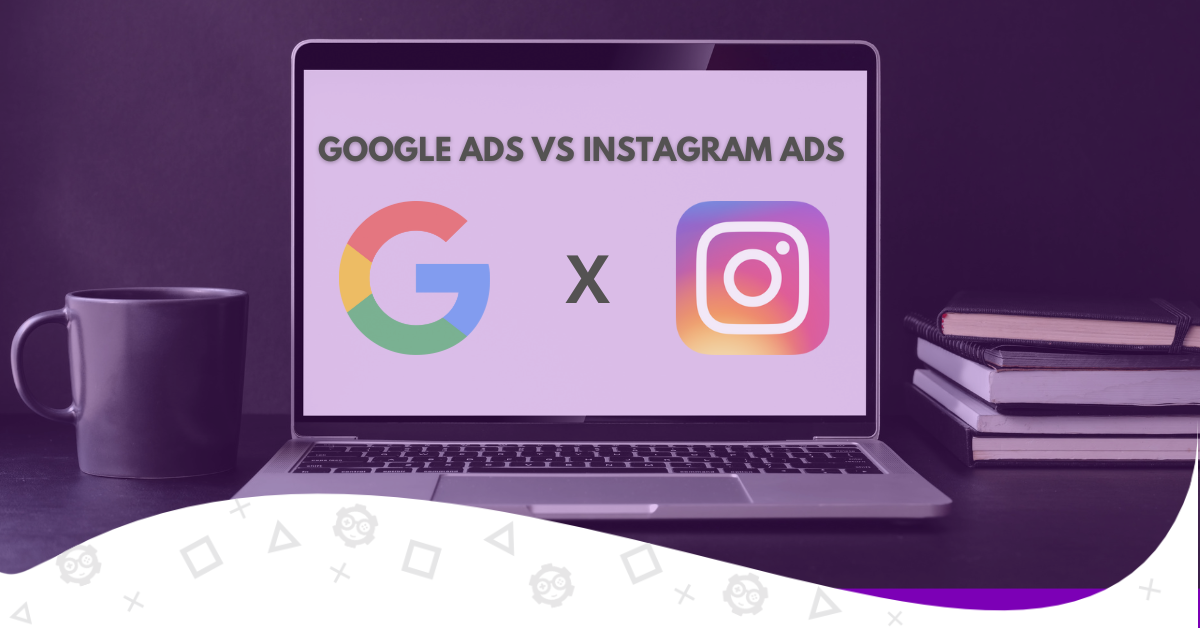In the vast and ever-evolving landscape of online advertising, choosing the right platform to promote your business is crucial for success. Google Ads and Instagram Ads are two formidable giants in digital advertising, each offering unique advantages and catering to distinct audience segments.
In this comprehensive comparison, we’ll be comparing Instagram Ads and Google Ad platforms, shedding light on their features, benefits, and suitability for various marketing objectives. Whether you aim to drive website traffic, increase brand awareness, or generate leads, understanding the strengths and weaknesses of these advertising platforms will empower you to make informed decisions and maximize your advertising ROI.
This article is a segment of a more extensive piece about Google Ads vs Social Media Ads.
What is Google Ads?
Google Ads, formerly known as Google AdWords, is a dominant force in online advertising. It operates as a pay-per-click (PPC) advertising platform, allowing businesses to create and display ads within Google’s search results and across the Google Display Network. This powerful advertising platform enables advertisers to connect with users actively searching for products or services on Google, making it an ideal choice for targeting users with high buyer intent.
What is Instagram Ads?
On the other hand, Instagram Ads is an integral part of Facebook’s advertising offerings. Leveraging the immense popularity of the Instagram platform, businesses can reach a diverse and engaged audience through visual ads displayed on users’ Instagram feeds and stories. Instagram Ads tend to be more visually oriented, making them an excellent choice for brands looking to convey their message through high-resolution images and videos while harnessing the social networking aspect of the platform.
Now, let’s dive deeper into each platform’s specific features and benefits to help you decide which one aligns better with your digital marketing strategy.

Differences Between Google Ads and Instagram Ads
When advertising your business online, understanding the distinctions between Google Ads and Instagram Ads is essential. These platforms offer unique features and benefits, catering to diverse advertising goals and target audiences. Let’s explore the key differences that set them apart:
Advertising Platform Focus:
Google Ads: Google Ads primarily operates as a search-focused advertising platform. It allows businesses to bid on keywords and search terms, ensuring that their ads appear as search ads when users enter specific queries.
Instagram Ads: On the other hand, Instagram Ads leans toward social media advertising. It thrives on the visual nature of Instagram, enabling businesses to create visually captivating ads to engage users as they scroll through their feeds.
Target Audience and Intent
Google Ads: Google Ads taps into the immense search volume on Google, connecting businesses with users actively seeking information, products, or services. This high level of buyer intent makes it ideal for businesses aiming to capture potential customers at the moment of decision.
Instagram Ads: Instagram Ads target users based on their interests and behaviors rather than explicit search queries. It’s more about increasing brand awareness, reaching potential customers within the platform’s active user base, and fostering community.
Ad Formats
Google Ads: Google Ads offers a variety of ad formats, including search ads, display ads, shopping ads, and video ads. These formats cater to different sales funnel stages and allow advertisers to incorporate rich visual elements where appropriate.
Instagram Ads: Instagram introduced ad formats tailored to its platform, such as Instagram Ads and Stories Ads (also implemented on Facebook Ads). These formats emphasize high-resolution images and videos, making them well-suited for brands aiming to convey their message visually compellingly.
Targeting Options
Google Ads: Google provides extensive targeting options, allowing advertisers to fine-tune their campaigns based on keywords, demographics, location targeting, and more. This granularity ensures ads are shown to the most relevant audience.
Instagram Ads: Instagram offers targeting options, including demographic targeting, interests, and behavior targeting. Advertisers can reach specific audience segments within Instagram’s user base.
Ad Quality and Cost
Google Ads: Ad quality in Google Ads is assessed through factors like ad relevance, click-through rate (CTR), and quality score. High-quality ads rarely go unnoticed, and advertisers can optimize campaigns to balance visibility and cost.
Instagram Ads: Instagram Ads are known for their high-resolution images and visually appealing content. While the average cost per click (CPC) may vary, creating visually stunning ads can lead to better engagement and conversion rates.
Mobile vs. Desktop Focus
Google Ads: Google’s advertising offerings extend across both mobile and desktop devices, allowing advertisers to target users on the go and those using desktop computers.
Instagram Ads: Instagram is predominantly a mobile platform, making it an ideal choice for businesses looking to connect with users on smartphones and tablets.
Ad Extensions and Features
Google Ads: Google Ads offers various ad extensions and features, such as site link extensions, callout extensions, and structured snippet extensions, to enhance the visibility and relevance of ads.
Instagram Ads: Instagram’s ad format is more streamlined, typically featuring a call to action (CTA) button and a link to a landing page.
Understanding these differences is crucial for selecting the appropriate advertising platform that aligns with your business goals, budget, and target market. Both Google Ads and Instagram Ads have their strengths, and smart advertisers leverage them strategically within their digital marketing strategy to accomplish their marketing objectives effectively.

The Pros and Cons of Google and Instagram Ads
As businesses venture into the dynamic realm of digital advertising, it becomes imperative to weigh the pros and cons of available platforms. Google Ads and Instagram Ads, two of the world’s most powerful advertising platforms, offer unique opportunities and challenges for advertisers.
This section will delve deeper into the advantages and disadvantages of both Google and Instagram Ads, helping you make informed decisions that align with your specific business goals and target audience. From immense search volume and high buyer intent to visual appeal and active user engagement, each platform presents a distinctive landscape for your advertising endeavors. Let’s explore these advertising giants’ strengths and potential pitfalls to empower your digital marketing strategy.
Pros of Google Ads:
Immense Search Volume: Google is the de facto leader in search engines, with billions of users conducting searches daily. This offers an immense audience for businesses to tap into.
High Buyer Intent: Users on Google are often actively searching for specific products or information, indicating a high level of buyer intent. This makes Google Ads ideal for capturing potential customers at the moment of decision.
Diverse Targeting Options: Google Ads provides extensive targeting options, including keywords, demographics, location, and more. Advertisers can precisely define their target audience.
Quality Score and Ad Optimization: Google’s Quality Score system rewards high-quality ads with better ad placements and lower costs. This incentivizes advertisers to create compelling and relevant ads.
Ad Formats: Google Ads offers a range of ad formats, from text-based search ads to visually rich display and video ads. This diversity accommodates different stages of the sales funnel.
Comprehensive Reporting: Google Ads provides detailed performance metrics and analytics, enabling advertisers to evaluate ad quality and campaign effectiveness.
Cons of Google Ads:
Competition and Costs: Certain keywords can be expensive to bid on in highly competitive industries, leading to a higher average cost per click (CPC).
Learning Curve: Managing Google Ads campaigns effectively requires a solid understanding of keywords, bidding strategies, and campaign optimization, which can be daunting for beginners.
Ad Fatigue: Users may become less responsive to ads over time if they see the same elements repeatedly.
Ad Blockers: Some users employ ad blockers, limiting the reach of Google Ads.
Pros of Instagram Ads:
Visual Appeal: Instagram is known for its visually engaging content. Instagram Ads leverage high-resolution images and videos to capture users’ attention effectively.
Active User Base: Instagram boasts a large and active user base, making it an ideal platform to connect with a diverse audience, particularly those aged 18-34.
Engagement: Users on Instagram tend to engage with content by liking, commenting, and sharing, offering opportunities for increased brand interaction.
Targeting Options: Instagram Ads allow for precise targeting based on demographics, interests, and behaviors, helping advertisers reach specific audience segments.
Mobile Focus: As a primarily mobile platform, Instagram Ads are well-suited for businesses looking to connect with users on smartphones and tablets.
Cons of Instagram Ads:
Limited Ad Formats: While Instagram offers visually appealing ad formats, the options are more limited than Google Ads. This may not suit all advertising goals.
Ad Placement: Ads on Instagram are integrated into users’ feeds and stories, which may lead to ad blindness or users simply scrolling past them.
Ad Relevance: To succeed on Instagram, ads must resonate with the platform’s culture and aesthetics. Poorly designed or irrelevant ads may not perform well.
Cost Per Click: Instagram Ads can be slightly cheaper than Google Ads, but the cost per click (CPC) can vary depending on the industry and audience.
In summary, Google Ads and Instagram Ads have strengths and weaknesses. Google Ads excels in reaching users with high buyer intent through search advertising. At the same time, Instagram Ads leverage the power of visual content and social engagement to connect with a younger and more visually oriented audience. The platform choice should align with your advertising goals, target audience, and budget. Smart advertisers often incorporate both platforms into their digital marketing strategy to maximize their reach and impact

Maximizing ROI with Advanced Advertising Strategies
Achieving a high return o investment (ROI) is the ultimate goal for businesses and marketers alike. To navigate this complex landscape effectively, it’s essential to compare the advanced features and strategies of these two advertising giants.
Google Ads
The cornerstone of digital advertising, thrives on the intent behind the user’s search queries. When potential customers go to the search engine seeking information or solutions, Google Ads offers advertisers access to this immense audience with high buyer intent. Leveraging the vast search network encompassing Google users around the world, businesses can tap into the amazing search volume generated daily.
One of the key strategies in Google Ads is to evaluate ad quality continuously. Advertisers must craft high quality ads that resonate with specific words and search terms relevant to their target audience. This not only drives down the average cost per click (CPC) but also ensures that ads are shown to users actively searching for products or services. Furthermore, Google’s advanced targeting options enable advertisers to tailor their campaigns to specific audience features, optimizing their ads to reach the right people at the right time.
Instagram Ads
Instagram Ads offer a unique opportunity to engage users through visual storytelling. Instagram Feed Ads, displayed alongside search results and within the platforms engaging environment, are a powerful tool for building brand awareness and connecting with an audience through high resolution images and compelling content.
Instagram Ads cater to an audience that appreciates more visual ads, making it ideal for businesses seeking to reach a visually oriented demographic. Leveraging Instagram active users, advertisers can use text based advertisements and proprietary artificial intelligence to craft ad campaigns that resonate with prospective customers on a personal level. This platform’s advanced targeting options allow advertisers to drive users through Instagram placements while also reaching existing customers and a very niche audience.
Comparing Google Ads with Social Media Ads: Choosing the Right Platform for Your Business
Check out these insightful articles to help you understand the distinctions between Google Ads and different social media Ads:
- Google Ads vs Facebook Ads,
- Google Ads vs LinkedIn Ads,
- Google Ads vs Tiktok Ads,
- Google Ads vs Twitter Ads.
Conclusion
In the vast digital advertising arena, making informed choices between Google Search Ads and Instagram Ads is paramount. We’ve navigated the intricacies of these platforms, from Google’s search engine-centric prowess to Instagram’s visually captivating allure. However, beyond this comparison, the digital marketing landscape boasts advanced features, short headlines, and countless opportunities that continually reshape the advertising ecosystem.
As you set your sights on ideal customers and marketing objectives, remember that success hinges not solely on budget size but on the strategic fusion of creativity and data-driven decision-making. Whether you opt for Google’s search ad campaign or Instagram’s visual charm, the key lies in comprehending your audience, adapting to algorithmic nuances, and refining your strategies.
As you journey through the digital advertising terrain, do so with confidence. The potential to reach the right audience at the right time, with the right message, is vast. Whether you’re a seasoned advertiser or a newcomer, the digital advertising universe serves as your canvas for crafting impactful campaigns. Embrace the challenges, seize the opportunities, and chart your course to advertising success by harnessing the power of Google Display Ads, Facebook and Instagram Ads, and the ever-expanding array of digital advertising tools and platforms at your disposal.

A PPC specialist who started with organic social media. For several years, the core of his activities are:- Google Ads, Microsoft Ads, Meta Ads, TikTok Ads, Twitter Ads, Linkedin Ads. He has led campaigns with a global reach, e.g. for FootballTeam, G2A, ETOTO, as well as many smaller campaigns in the sports, construction and financial industries. Has full focus on ROAS. Privately, a fan of football, history of wars and Star Wars.

